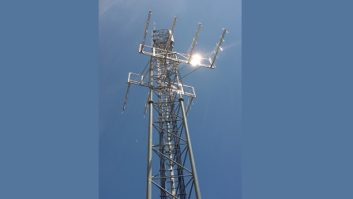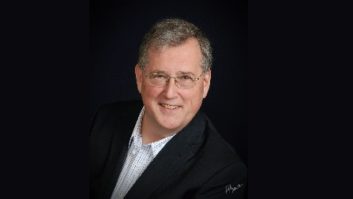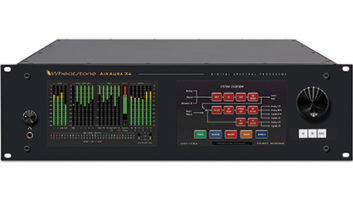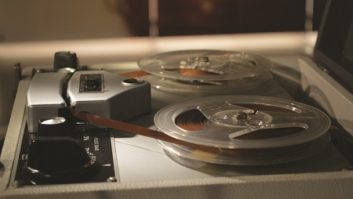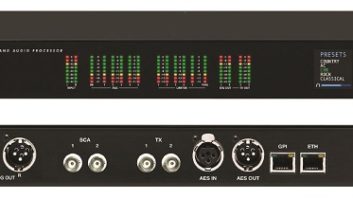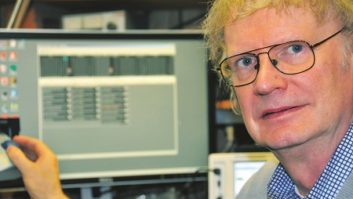
Fig. 1: A simplified linear detector circuit of the Bose FM multiplex detector from the patent documents.

Fig. 2: John Bose enjoys a hearty meal in the Alpine FM transmitter building in July, 1939. Bose had a long working association with Armstrong.
Photo by KE2XCC Chief Engineer Perry Osborn Major E. H. Armstrong transmitted the first super-audible subcarrier signals from his experimental FM station, W2XDG, on 41 MHz, which was located on the 85th floor of the Empire State Building in New York City. These signals were first transmitted in November 1934 and consisted of the main channel audio program and three subcarriers: a facsimile program, a synchronizing signal for the facsimile program and a telegraph “order” channel. These original subcarriers were amplitude modulated. Subsequently, two musical programs, consisting of both the Red and Blue Network program feeds of the NBC Radio Network, were simultaneously transmitted using the same system of subcarrier modulation.
In April 1935, the amplitude modulated subcarriers were replaced by frequency modulated subcarriers, with much improved results.
This subcarrier receiver technology was conceived and developed jointly by Maj. Armstrong and John H. Bose, and U.S. Patent No. 2,835,803 for the technology was filed on Oct. 12, 1953. Fig. 1 shows the simplified linear detector schematic from the patent filing. It’s interesting to note that Bose uses what is probably the first application of a 90-degree quadrature pulse FM detection technique in his subcarrier demodulator. Two 90-degree-separated carriers of the original FM modulated subcarrier frequency are combined in a type 6BN6 gated beam electron tube. This special tube serves to separate the original transmitted audio modulation from the carrier wave, using quadrature pulse techniques. The demodulated signal from the tube is then de-emphasized and low-pass filtered to produce the original transmitted audio signal. This is the same concept that is used in the proto receivers on display at the Alpine museum.
John Bose was an electrical engineer who worked closely with the major, both at Armstrong’s laboratory at Columbia University in New York City and at the major’s experimental FM stations W2XMN and KE2XCC, both located in Alpine, N.J. Alpine is the site of the world’s first FM broadcast station, W2XMN. A July 1939 picture (Fig. 2) shows Bose enjoying a hearty bowl of spaghetti in the facility’s main brick building.
The first FM subcarrier transmissions emanating from the major’s experimental station KE2XCC at Alpine occurred in 1948. These transmissions consisted of two-channel audio programs, binaural audio programs and facsimile programs.
It was determined during these Alpine test transmissions that at the 1 millivolt broadcast contour line, the signal-to-noise level of the subcarrier channel for fluctuation noise was above 60 dB, using a single-dipole receiving antenna at a 30-foot elevation. It was also determined that a 70 dB signal-to-noise ratio of the subcarrier could be obtained by using higher-gain directional receiving antennas made with practical mechanical dimensions.

Fig. 3: The back of Bose’s 30 kHz FM subcarrier receiver. It was restored by the author for the Alpine museum and works well.
Photo by Dave Amundsen, CSC Management LLC
The Alpine subcarrier tests also revealed the ability to successfully transmit voice intelligence with received RF signals of only 10 microvolts at the subcarrier receiver antenna input terminals.
During the summer and fall of 1952, a series of tape recordings of the transmitted Alpine FM subcarrier signals were made at Bayport on Long Island. This location is approximately 50 miles from Alpine. The results of the recordings indicated that the quality of reception of the subcarrier signals was uniformly superior to the signals broadcast by several 50 kW AM standard broadcast stations located in the New York City area.
An article in the November-December 1953 edition of Communications Engineering magazine covered Armstrong and Bose’s Oct. 13, 1953 presentation to the Radio Club of America on this novel technology. The magazine enthused that the use of FM subcarriers “opens up possibilities for new types of systems or services because of the enormous [reception] coverage available.”

Fig. 4: The receiver rack at the Alpine museum. The 93.1 MHz main channel receiver is at the top of the rack, with the 30 kHz FM side-channel multiplex receiver below it.
Photo by Dave Amundsen, CSC Management LLC
The article contemplated that the use of these subcarriers would be useful for business-to-business communication. “Consider how advantageously two long-range channels could serve a manufacturing company that had plants and offices in outlying sections of a city where there is an FM station. One channel could be used for [one-way] communication with company cars and trucks, while the other could be free to serve for special messages and paging.”
Today at Alpine, we have two of the original prototype FM subcarrier receivers that were first used by the major for testing at KE2XCC in 1948, as seen in Figs. 3 and 4. These units are both fully restored and operational within our museum site. The original subcarrier frequency that they operate on is 27.5 kHz. The IF bandwidth is +/–5 kHz. It should also be noted that 75 microsecond audio de-emphasis is deployed in these prototype units, as well.
We have both Maj. Armstrong and John H. Bose to thank for the development and early field testing of FM multiplex subcarrier technology. Their early pioneering work laid the foundation and established the concepts underlying modern FM multiplex techniques. This work allowed for the creation of paid music and program subscription services for the FM broadcast industry as a whole.
Steve Hemphill is owner of Solid Electronics Laboratories, an FM broadcast equipment manufacturer. He performs design consulting work for other broadcast equipment manufacturers including Harris Broadcast (GatesAir) and Belar Electronics Laboratory. He is one of the museum curators at the Alpine Tower, site of the world’s first FM broadcast station. He is licensee of WA2XMN, Major Armstrong’s memorial Experimental FM broadcast station at Alpine, N.J., which is on the major’s original frequency of 42.8 MHz.
REFERENCES
“Some Recent Developments in the Multiplexed Transmission of Frequency Modulated Broadcast Signals,” by E.H. Armstrong and John H. Bose. This paper was presented before the Radio Club of America in New York City on Oct. 13, 1953.

